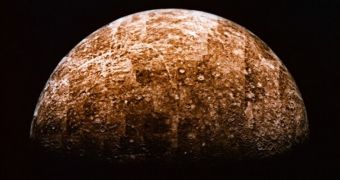In a paper published in yesterday's issue of the journal Nature Geoscience, researchers argue that, all things considered, chances are that planet Mercury's current makeup is the result of cosmic hit-and-runs that occurred billions of years ago.
More precisely, scientists now claim that, according to evidence obtained while running several computer simulations, it is very likely that Mercury's rather peculiar anatomy is the result of grazing collisions with a planet about as big as Earth.
Writing in the journal Nature Geoscience, researchers explain that, as shown by previous investigations, Mercury's iron core currently accounts for about 65% of the planet's overall mass.
This is fairly strange, especially given the fact that, in the case of Earth, Venus and Mars, the iron core only makes up approximately 30% of these rocky planets' overall mass, the astronomers behind this research project go on to detail.
To add to the mystery, information obtained with the help of the MESSENGER spacecraft, which was launched back in August 2004, indicates that this planet in our solar system sports volatile elements in its crust.
This is peculiar because, if the planet was in fact the victim of massive collisions that stripped away much of its rocky mantle billions of years ago, volatile elements like the ones documented by MESSENGER should not be present in its mantle.
Having pieced together and analyzed several computer models, researcher Erik Asphaug with the Arizona State University in the United States and specialist Andreas Reufer, who is also working with the University of Bern in Switzerland, believe to have solved this puzzle.
In a nutshell, these astronomers argue that the planet's current anatomy could be the result of hit-and-run collisions between a proto-Mercury and other celestial bodies. These collisions caused proto-Mercury to lose its mantle, but did not remove all traces of volatile elements.
“To explain the mystery of Mercury’s metal-rich composition, ASU’s Asphaug and Andreas Reufer of the University of Bern have developed a new hypothesis involving hit and run collisions, where proto-Mercury loses half its mantle in a grazing blow into a larger planet (proto-Venus or proto-Earth).”
“One or more hit and run collisions could have potentially stripped away proto-Mercury’s mantle without an intense shock, leaving behind a mostly-iron body and satisfying a number of the major puzzles of planetary formation, including the retention of volatiles,” reads a press release on the Arizona State University's website.
Erik Asphaug and Andreas Reufer say that, in order for Mercury in its current form to have formed, about two, maybe even three such cosmic hit-and-runs need to have taken place. The researchers add that, even if their model is true to facts, there are several questions that need be answered.
For example, it is unclear where the bodies that collided with Mercury came from, where they are now, and how the heat generated during the hit-and-runs affected the planet's makeup in the long term.

 14 DAY TRIAL //
14 DAY TRIAL //